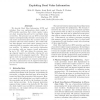Free Online Productivity Tools
i2Speak
i2Symbol
i2OCR
iTex2Img
iWeb2Print
iWeb2Shot
i2Type
iPdf2Split
iPdf2Merge
i2Bopomofo
i2Arabic
i2Style
i2Image
i2PDF
iLatex2Rtf
Sci2ools
MICRO
1997
IEEE
1997
IEEE
Exploiting Dead Value Information
We describe Dead Value Information (DVI) and introduce three new optimizations which exploit it. DVI provides assertions that certain register values are dead, meaning they will not be read before being overwritten. The processor can use DVI to track dead registers and dynamically eliminate unnecessary save and restore instructions from the execution stream at procedure calls and context switches. Our results indicate that dynamic saves and restore instances can be reduced by 46% for procedure calls and by 51% for context switches. In addition, save/restore elimination for procedure calls can improve overall performance by up to 5%. DVI also allows the processor manage physical registers to efficiently, reducing the size requirements of the physical register file. When the system clock rate is proportional to the register file cycle time, this optimization can improve performance. All of these optimizations can be supported with only a few new instructions and minimal additional har...
| Added | 06 Aug 2010 |
| Updated | 06 Aug 2010 |
| Type | Conference |
| Year | 1997 |
| Where | MICRO |
| Authors | Milo M. K. Martin, Amir Roth, Charles N. Fischer |
Comments (0)

